"OK, I'm done."
I vividly remember reading that short, punchy sentence again and again in my first few weeks at Zapier, each time pursing my lips, scrunching my forehead and thinking, "How did Wade finish that task so fast? Geesh, I'm slow."
Zapier is my first job on a remote team. Prior to my time here, I spent two years in a co-located corporate cube farm and four years in a regional media company. Never, though, had I been a part of an organization in which each team member is on their own, dictating their own hours, office setup, and work environment.
For my boss—Zapier co-founder Wade Foster—and the half-dozen other individuals on the team when I joined, this freedom gave rise to a higher level of productivity, too. Or so they felt.
"Non-remote work defaults to the highest distraction communication first, which is in-person. Remote work defaults to the lowest, which is no communication," said Zapier co-founder Mike Knoop when I asked him if he felt he worked faster in a remote team.
"Fewer distractions lead to faster work," Mike added. "You have to purposely decide to enter into more distracting conversations."
For Wade, it's been a similar experience.
"Fewer distractions," he said when asked the same question. "I don't get sucked into side conversations. No one plays crappy music really loud. I don't get hit in the head with a Nerf ball."
"Things are more to the point," he added.
Of course, those are Zapier co-founders speaking; they are, without a doubt, biased on this topic. So what about my teammates at Zapier or members of other remote organizations: Do they find the distributed team structure increases productivity? And if so, why? I went searching for input.
Are You More Productive?
Have you found working on a remote team has resulted in you working faster, more productively? If yes, how? If no, why do you think not?
That's the question I sent out to a dozen colleagues in the remote working world. Tabulating the nine replies that came back, six individuals said "yes," two said "yes and no," and one replied he "wouldn't say that working with a remote team has really affected the pace of my work." And though these nine answers vary, there is a constant theme: a remote working environment allows for a faster pace of work. Whether or not that's the intention of the remote employer, it's the common outcome.
Belle Cooper—co-founder of Hello Code based in Melbourne—summed it up best in her response.
"Working remotely has definitely led me to find ways to work faster," Cooper says. "It didn't happen naturally as a result of remote work, but the freedom of remote work means I can experiment with different work spaces, different work times and approaches, and find what works best for me as well as what helps me work fastest."
It didn't happen naturally as a result of remote work, but the freedom of remote work means I can experiment … and find what works best.
Belle Cooper
Complementing Cooper's take is Zach Leatherman, an Omaha-based web developer part of the remote Filament Group team, who points out that it's a two-sided equation.
"In my opinion, remote work can only succeed in environments that have little red tape and low barrier to decision making," he says. "If employees don’t have freedom and independence to make decisions, remote work will be less effective."
So when both parties are present—the freedom-giving remote employer and the productivity-seeking remote employee—work happens at a faster pace. Could it be that simple? The trait "propensity towards action" is, after all, one that we look for in candidates when we're hiring.
We could boil it down to that, but it would leave out some of the unique characteristics that define remote work. Knoop's comment, for example, is that remote work inherently cuts down on distracting conversations because a majority of the communication is written rather than verbal. So whether or not the individual has an aim to increase their productivity, when they're in the remote environment Knoop describes, they'll be more productive.
Putting that to the test, I asked my teammates and a group of nine colleagues for examples of how being part of a remote team has helped them work faster. Here are eight of the ways they offered, followed by a few ways in which they work slower, too.
How to Work Faster in a Remote Team
1. Pull Internal Communication Out of Your Inbox
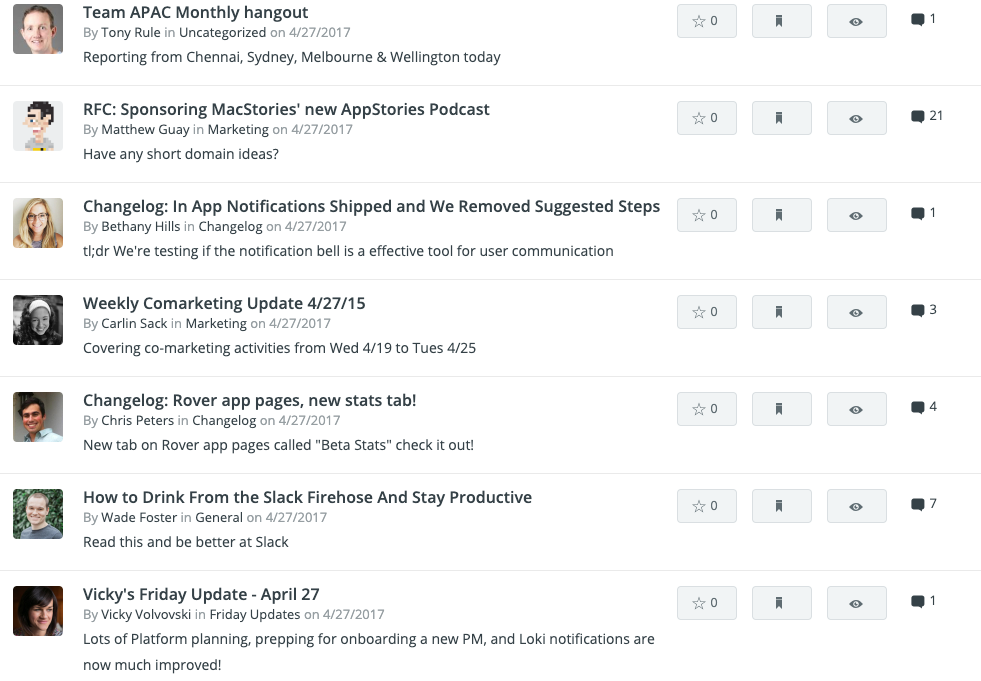
Think about the number of words you speak each day—3 minutes of conversation with your favorite barista, 15 minutes on a conference call with a new client, 30 minutes unpacking your day with a friend or your spouse over dinner. Now imagine typing all of those conversations out in email form. That's the majority of remote communication.
By default, these conversations and others like it fall into your inbox and pile up, waiting for you to read and reply. And that's exactly what you do—people spend 3+ hours a day on work emails.
One of the best things we did early on to thwart this imminent mess of email as the Zapier team grew, was take an inventory of which conversations belonged in our inboxes and which ones belonged elsewhere for the sake of context and convenience. The result: Only two types of internal emails remained. (The emails: team feedback following an applicant's group interview and announcements of new hires.)
Company and department updates, project specs, design mock-ups, and individual "Friday Update" reports moved from email to our private internal blog, and the aggravating "Reply All" emails that accompanied them became easy-to-read threaded comments. Team and department feedback, along with questions and discussions, moved to team collaboration and chat app Slack, which replaced one-on-one email threads with its private messaging feature, too. And Slack even became the place we find out about new public and private blog posts with a Zapier integration.
It's tough to put a total "time saved" figure on the email changes inside our team, but that's ok because it's not the only—or even the best—result. What's best is the order it brings—assurance that when there's a new email, it's meaningful, and when there are five replies to a department update on our internal blog, they're quick to read (and "like," too).
Or as Andreas Klinger, Head of Remote at AngelList, puts it: "Communication feels cheap to do but often adds up to a lot of time costs and very often only results in more communication (unless framed in processes)." Streamlining communications and cutting down on the back-and-forth emails is the true benefit of pulling communications out of your inbox.
Communication feels cheap to do but often adds up to a lot of time costs.
Andreas Klinger, Product Hunt
That said, your team might not need to pull internal communication out of your inbox to find benefits. The team behind payments remote-friendly company Stripe kept their email intact but added structure such as advanced Gmail filters.
Slack works for our team—it keeps us out of the inbox and frees up our time to work on more important projects. But what matters is finding an efficient communication model for you and your team.
2. Rely on the Right Tools

We love apps at Zapier. We're constantly playing around with them, integrating them into our own platform, and trying them out in our workflows.
So as we moved email threads out of our inboxes, we needed to find an app for each convo. Slack absorbed most of the load, but not all. Progress updates around our editorial calendar moved into Trello, a highly customizable project management tool. Step-by-step guides teaching fellow co-workers, for example, how to instigate a drip campaign moved into Hackpad, a collaborative documentation tool, and then into Quip when Hackpad shut down. And before we relied on our private internal blog for weekly updates, we used iDoneThis, an app that makes it easy to record the tasks you accomplished.
When your remote team lands on the right tools, you can really get in the groove. That was an experience shared by Matthew Makai, a remote employee on Twilio's team, another company that's split between co-located and distributed employees.
"My colleague Ricky Robinett and I wrote this blog post on our new TaskRouter API together while he was in NYC and I was in D.C.," Makai says, noting several other colleagues gave their input on the piece, too.
"I felt like we were more efficient than if we were in-person because we had a mastery over our communication tools, including Google Docs, Trello, Flowdock, and video chat. If we were in the same room, I don't believe it would've worked as well because the writing-review-revision feedback loop is inherently asynchronous, so we all worked on our own schedules."
We were more efficient than if we were in-person because we had a mastery over our communication tools.
Matthew Makai, Twilio
Scott Hanselman, a Microsoft employee who works remotely from Portland, best sums up the remote worker's approach to trying and using tools when you need something outside your essential toolkit.
"We use Lync at work, but I also use Skype, GChat, Join.me, straight VNC, Windows Remote Assistance, CoPilot and a dozen others," he says. "If one doesn't work for some reason, don't waste time, just move to the next one."
Once again, the time savings of being remote might come directly from being remote, but perhaps also because you're forced to try new tools that work great remotely and can also speed you up.
See Tools of Remote Teams: Google "remote team tools" and you'll discover what's working best for the teams at Ghost, Buffer, Hanno, Groove, and others.
3. Use Differing Schedules to Your Advantage
Makai, in the quote above, found that the flexible schedule that comes with a remote team speeds up his writing and editing process. And he's not the only one: Among the individuals polled for this piece, the most popular answer for how remote work enables individuals to work faster is the ability to decide one's hours.
IDoneThis founder Walter Chen uses his adjustable schedule to get over his "2 p.m. post-lunch lull."
"When I was a lawyer, I had to close the door of my office and put my head down on the desk for a quick nap. Still, you can imagine that the head-down on the desk nap isn't as refreshing as it could be," he says. "Now that I work remotely, I'm able to lie down for a nap or go to the gym for a quick workout, which gives me a huge energy boost."
Joe Stych, a Minneapolis, Minnesota-based team member at Zapier, has a different take on the schedule offered by remote companies, one that means maximizing his allotted time.
"At my old job, productivity was zero after 4 p.m.—I was counting down the minutes until I got in my car or just refreshing my email to make sure my boss didn't send me something," Stych says. At Zapier, he's nestled in his home office, working until he signs off Slack.
For some teams though, making the most of the schedule doesn't mean working when most productive, but always staying productive because you can work around the clock.
"We're spread over a number of different time zones all over the world, so our development is 24/7," says Groove founder and CEO Alex Turnbull. "Even when those of us in the U.S. are sleeping, our developers in Europe and South Africa are hustling. Customers can get help at any hour, and production never stops."
Inside Zapier, we take advantage of this benefit, too. My marketing teammate Matthew Guay, for example, is based in Thailand, so our clocks are opposite—when it's 8 a.m. in Omaha, it's 8 p.m. in Bangkok. At the end of the workday, I'll often hand off a piece to Matthew for editing. When I wake up the next morning, it's all marked up. Never in my many years on an editorial team have I had the quick workflow offered by this unique situation.
4. Skip the Commute
"We save, collectively, dozens of hours each week on commuting," says Groove's Turnbull. "Those hours go into getting things done, and over time, that amounts to massive, massive wins."
Zapier co-founder and CEO Wade Foster has a similar take. "I jump right into work when I'm ready. And leave when I'm done. There's zero friction between working and not."
We save, collectively, dozens of hours each week on commuting.
Alex Turnbull, Groove
While this is perhaps the most-heralded aspect of remote working, it might be one that's underutilized, as well. In essence, the commute, be it 15 minutes or 50 minutes, is found as an excess when you're remote working. Why spend time in the car when you can get right down to it at your home office?
Applying that same principle to other activities yields a productivity boost, as well. Instead of leaving your office to grab lunch, for example, prepare it that morning, as if you were commuting. Rather than go for coffee in the afternoon, rely on a thermos or switch to tea, which makes preparation easy. Look to cut excess from your team's processes, too. Instead of holding that weekly stats recap meeting, for example, spin up an internal blog post that details the numbers.
5. Cancel Meetings
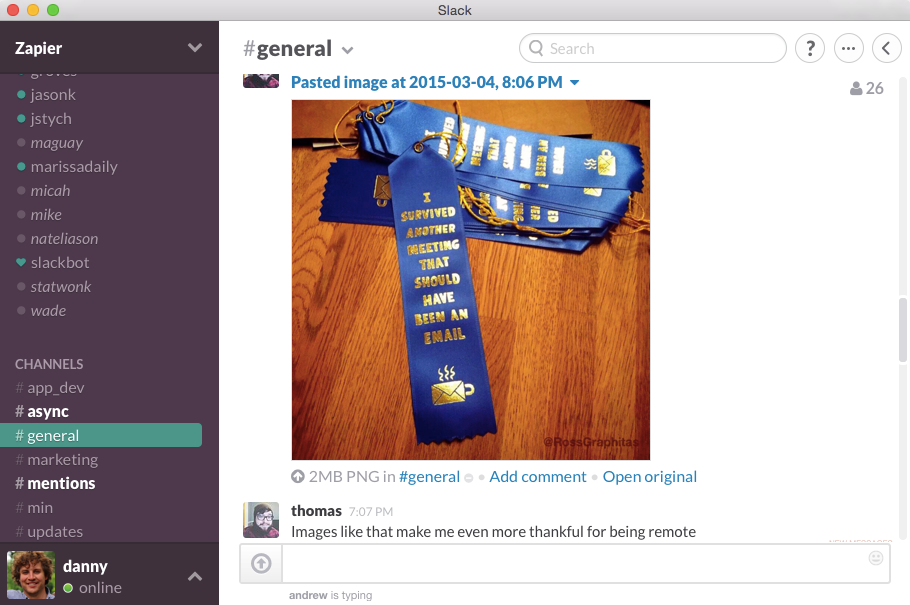
"Hey, can you hear me?" … "How about now?"
You'd never say that when you've stepped aside for an impromptu meeting, but it's a common occurrence when starting up a video conference call. This annoyance is surprisingly helpful though: You purposely try to avoid putting yourself in that scenario. Yes, as if meetings weren't bad enough, now you have to put up with fussy software that multiplies meeting pain.
So the best thing to do is ask yourself: Do we really need that meeting?
Start asking yourself that question and you'll start earning back dozens of hours monthly. (That's a potential 7,000 hours back for the unnamed organization in a report by Bain & Company).
The team at iDoneThis reconfigured their weekly meeting after giving it a second thought. They knew they wanted to hold a regular meeting for some important face-to-face contact, but the content of their meetings was ineffective.
"Since we didn’t set forth a specific enough protocol or purpose, the Hangouts were unfocused, devolved into rambling discussions about product, and ended up wasting our time," writes former iDoneThis team member Janet Choi. After consideration, they changed up the format to a more effective weekly show-and-tell session.
6. Think Before You Speak (Send)
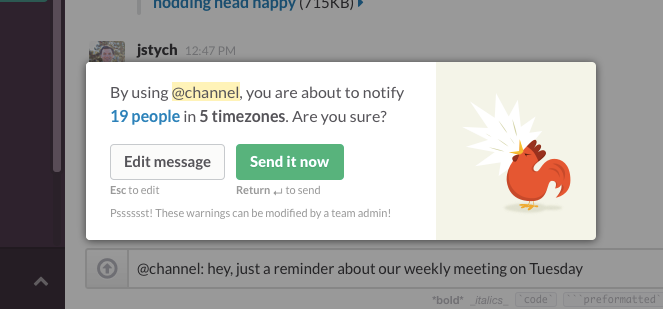
With a majority of communication on a remote team being in written form, you start to notice something about how you talk with your teammates: You put more thought into it. It's hard to just spout something out; you first must type it out, read what you've written, and then hit "send" or "publish." Those extra little steps add a helpful filter to your conversations. You end up thinking before you speak, yielding clearer and more concise communication. It's probably no surprise then that "proficient written communicator" is among the skills we look for when hiring at Zapier.
This is a tactic that can work for in-person teams, too. Amazon's Jeff Bezos, for example, bans Powerpoint presentations in meetings. Instead, he requires each attendee to come prepared with a memo, which is then read by the others before the meeting starts.
"Full sentences are harder to write," Bezos says in a Fortune article. "They have verbs. The paragraphs have topic sentences. There is no way to write a six-page, narratively structured memo and not have clear thinking."
If your company relies on a team chat application like Slack, you'll see this benefit, too.
"Things are more to the point," says Zapier's Foster. "In-person meetings tend to have lots of chit-chat, how's the weather talk. In chat, you skip over most of that and get right to the point."
7. Set Up Your Best Environment
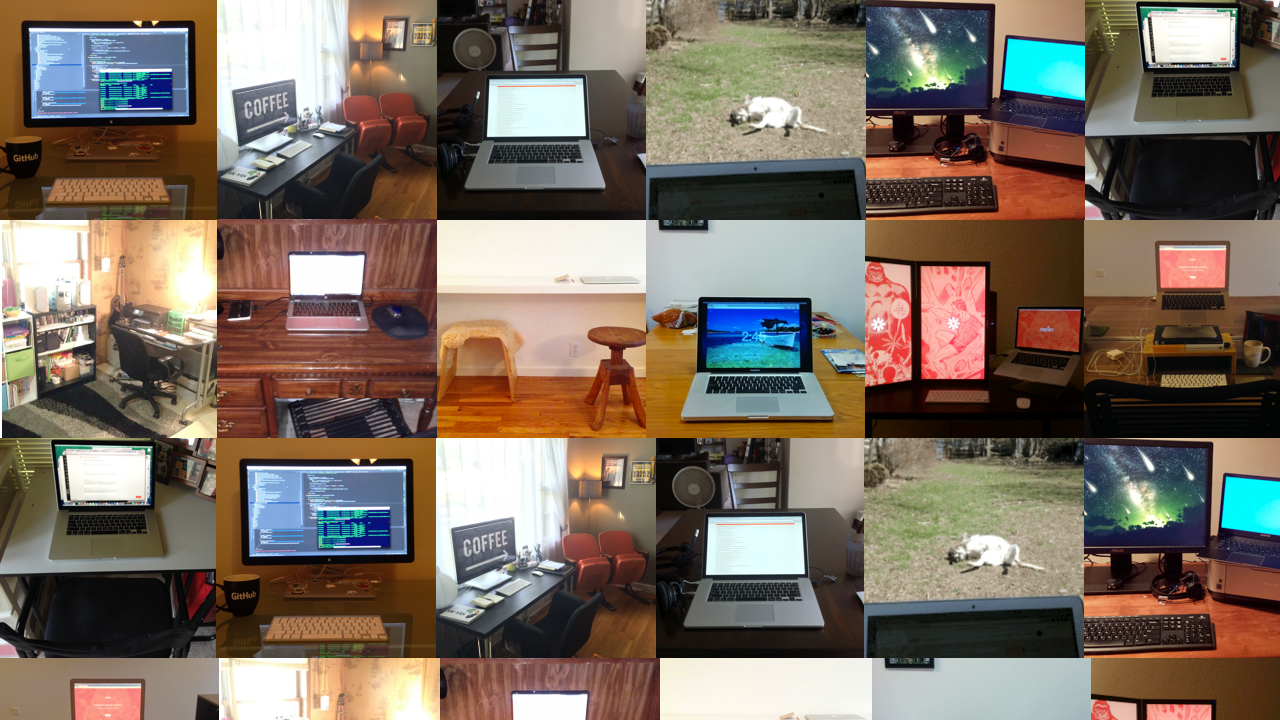
"If you ask people the question, 'Where do you really need to go when you need to get something done?' you typically get three different kinds of answers," says Jason Fried, the founder of Basecamp and co-author of bestselling book Remote: Office Not Required. One answer is a place, location or room, such as the porch or the coffee shop; another is a moving object, such as a plane or train; and another is a time, really early in the morning or on the weekends.
"You almost never hear someone say 'the office,' but businesses are spending all this money on this place called the office and they're making people go to it all the time. Yet people don't do work in the office."
It's like the front door of the office is like a Cuisinart and you walk in and your day is shredded to bits.
Jason Fried, Basecamp
Fried, who delivered these words on stage at TEDxMidwest 2010, says he's been asking people this productivity question for about 10 years.
The office, he says, is where "work moments" happen, not work days. "It's like the front door of the office is like a Cuisinart and you walk in and your day is shredded to bits because you have 15 minutes here, and 30 minutes there and then something else happens and you're pulled off your work … and then it's lunch."
Take those distractions away, and you can be a lot more productive. "People need to be able to be away from the distractions of the workplace to actually work and get things done," says Zapier Managing Editor Melanie Pinola, who pointed me to Fried's talk. "When I first started telecommuting, I found myself finishing my tasks much earlier than I had previously and ended up taking on more responsibilities…from home, because I just worked better in this environment."
Aside from the ability to dictate their schedule, the ability to control their environment is also a main factor for many remote workers' productivity.
"Having a quiet day at home to write means I get work done way faster," says Jimmy Daly, a Tucson, Ariz.-based content marketer.
Working from home allows you to quickly change your surroundings, too.
That's an upside Zapier's Guay has found. "Stand while you work or sit. Kneel at a table if that feels right for a bit. Sit back on the couch to edit or walk around the house with a draft to read over. Use speakers for music if you want…or have perfect silence."
Remote work also doesn't need to be restricted to your own abode—go wherever makes you productive.
"Often just being at home can drive you nuts," writes Microsoft's Hanselman. "I try to get out a few times a week. I've worked from the mall, from Starbucks, from McDonald's (free wi-fi, sue me) and from a park bench. I find that just having people walking around makes me feel more productive."
Related: Learn the best way to organize your desk and home office for maximum productivity and ergonomics.
8. Own Up to Your Productivity
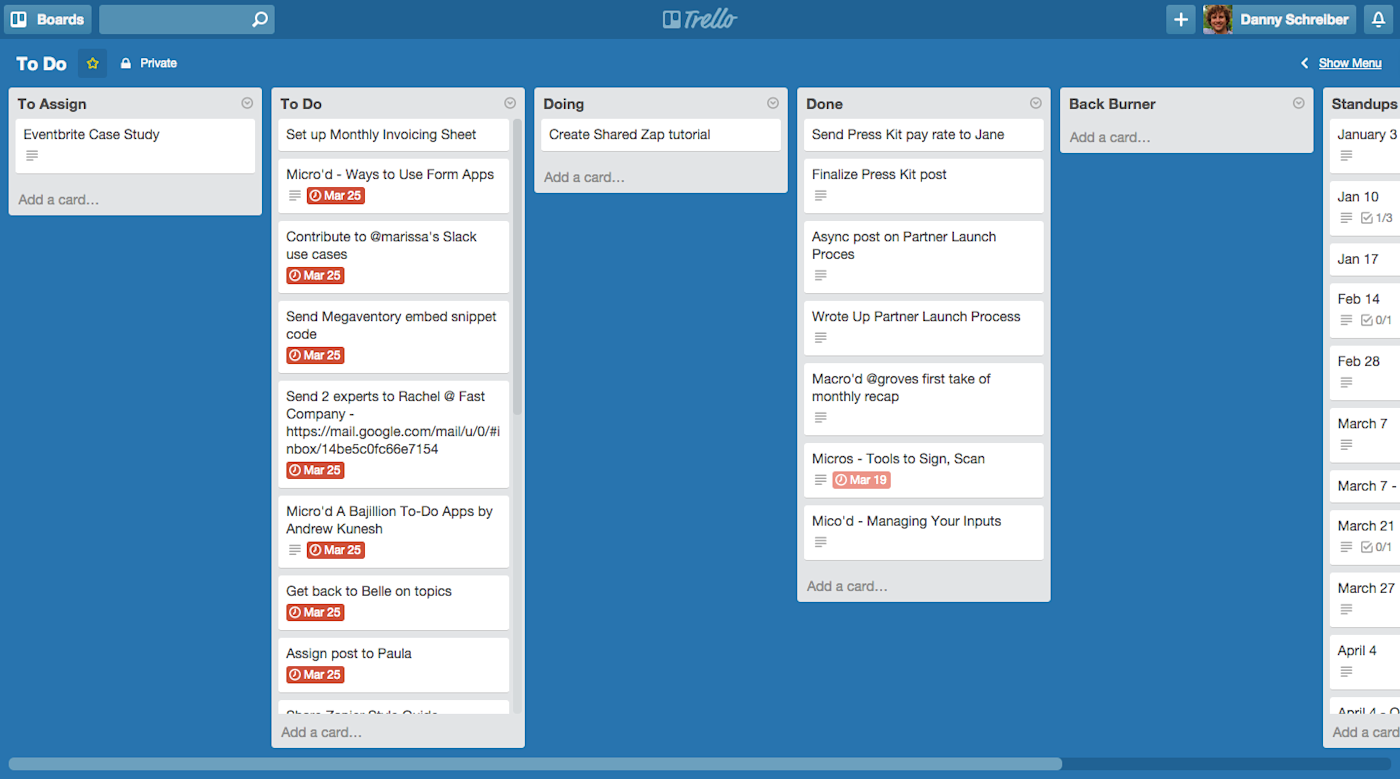
Whether it's working in your own home or a nearby coffee shop, there's another aspect that pushes remote employees to work faster: You're responsible for your productivity. Gone are the regular meetings and brainstorming sessions in "Conference Room 3B," and no more can you pull up a spreadsheet and stare at your screen to appear engulfed in busy work. You now must own up to what you did and didn't accomplish.
That's what motivated Cooper to cut down the time it took her to write a blog post from two days to four hours. She saw Buffer co-founder Leo Widrich churning out posts at a much faster pace than her, so she examined what could be holding her up. Between cutting out excess research and distractions like email, Cooper eventually narrowed in on how to author a quality blog post in the least amount of time necessary—just one morning.
"Now that I've proven to myself over and over that I can write a post in a morning without dropping my quality, they’re a lot less formidable in my mind," writes Cooper. "I think that makes a huge difference to how I work."
Personally, I've recently found keeping a tally of my to-dos on a Trello board helps me stay focused on what's most important that day. It also saves time at week's end, too, since I use a Zapier integration to copy all the cards in the "done" Trello column to a Google Doc, which I pull out each week. The average time it takes me to write my weekly recap for our internal blog instantly went from around 40 to 20 minutes.
Create Google Docs text files from new or moved Trello cards
It's a stretch to say all remote workers are inclined to be more productive, but the topic itself has become a theme on blogs of remote teams—including Trello's, RescueTime's, and, yes, Zapier's blogs.
Not So Fast… What Doesn't Work About Remote Work
As a remote worker myself, I'll admit to being biased in this piece and giving the most attention to the upside of the working arrangement. But there are downsides, too.
"There are times, of course, where working together would be faster," says Daly. "For example, when we redesigned our site, the process was slowed down by waiting for responses from people who were fast asleep in another timezone."
It's harder to communicate via typical in-person channels such as whiteboards.
Matthew Makai, Twilio
Twilio's Makai finds difficulty in being the lone remote team member when an in-person meeting is happening at the headquarters.
"The downside is when I'm working with a group of folks at HQ in San Francisco and I'm in D.C., it's harder to communicate via typical in-person channels such as whiteboards," he says, noting he circumvents this issue by visiting the office at least quarterly for in-person meetings.
I'll add one more to the list: shoddy internet. My home Wi-Fi has given me more trouble than I ever remember experiencing when I worked in an office building. And when the internet's out, well, productivity takes a hit (and your mobile hotspot comes to the rescue).
The Right Reason to Go Remote?
Whether you're a founder considering going remote or a professional contemplating joining a remote team, a major benefit to consider is the opportunity to amp your productivity. Between my own experience and conversations with over a dozen individuals for this post, it's clear that a remote workplace allows you to do just that. Whether or not you succeed at it is entirely up to you.
That said, to achieve this productivity boost, you might not need to go remote at all.
Thanks to the rise of instant messaging apps like Slack, collaborative editing tools like Google Docs, and file sharing tools like Dropbox, there's a shift in the way we all communicate at work.
"Pay attention to how much time you actually spend each day in the same room talking in real time to other people—it's far less today than ever in history (I don’t have data for this, but I’ve rarely heard counterarguments)," writes Scott Berkun, author of The Year Without Pants, a book about remote work.
"Even in companies that do not allow 'remote work,' remote work is encouraged implicitly by the equipment used and the daily working habits we’ve adopted across our culture."
Unplug
"OK, I'm done," I message Wade this time.
About six months into the job, I finally catch up to my new team's fast-paced environment. But it didn't come without pulling myself away from the team. My trick for writing faster, I found, is to completely unplug from the communication tools we use. Do this, and then put 100% focus on writing in a distraction-free environment. It works and I'm now working faster than ever before.




